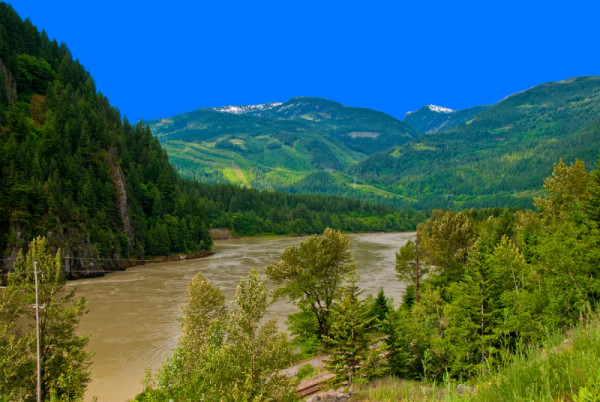Exploring the Fraser River Watershed
The Fraser River Watershed flows 1,370 km through British Columbia, from its source at Mt. Robson Provincial Park in the Rockies, to meet up with the Pacific Ocean, at the Strait of Georgia, in Vancouver. Covering a huge range of habitats and ecosystems, the river comprises of 12 unique watersheds each capturing a different aspect of the province’s varied and often rugged landscape.

The river’s path
Born in the mountains from melted snow, the river trickles through rough terrain along the Rocky Mountain Trench, where it progressively widens before hitting dry, desert-like conditions. The river’s flow rate changes greatly with the season, running at some 7,000 cubic meters per second in the spring and just 850 centimeters during the winter.
As the river winds down towards the Pacific, it spreads out, forming a coastal trough of sorts, ideal for farming with rich soil, seasonal floods, and high silt concentrations. These high silt concentrations, plus clay, gravel particles, and opportunistic bacteria and plankton, give the Fraser a distinctive colour that varies from white and milky in the Upper regions to a greyish tone near the southerly Lower regions as the river mixes with salt water.
Biodiversity in the Fraser
An incredible assortment of wildlife inhabit the river. More than 300 species of migratory and resident birds rely on Lower Fraser lands alone. During the spring migration season, some 500,000 western sandpipers a day have been estimated to visit the invertebrate-rich mudflats of Roberts Bank.
But the river is best known for its fish—salmon to be specific. Home to more salmon than anywhere else in the world. The river contains seven species of fish belonging to the genus Oncorhynchus five of which are commercially harvested species and 2 of which are import recreational species. Each spring an estimated 10 million salmon return to their home waters in Fraser lakes and rivers to spawn, but these numbers are greatly decreasing with each progressing year thanks to a combination of warming waters, pollution, overfishing, and farmed-fish parasites. Aside from its famous salmon, the river boasts another 29 fish species and 87 more in the surrounding estuary.
Experience the river’s beauty
Each year scores of tourists flock to the area to catch some of the sights that the river’s natural beauty offers up. Hell’s Gate, in the middle portion of the river, has one of North America’s only descending gondolas, taking visitors to see the canyons’ might close up—pushing 750 million liters of water through a passageway just 33 meters wide.
Another popular tourist destination lies in the upper portion of the river at Bowron Lake Park, where you can sign up for a six-to-10-day canoe circuit through the Bowron waterway, a world-famous 116 km series of 11 lakes and rivers connected by portage routes. Sport fishing, hiking, and whitewater rafting also lure big crowds to points along the Fraser.
Challenges for the future
There are five major challenges that the species and communities along the river must address. First is the diking and gravel removal from the gravel reach of the river is undermining the dynamic function of that stretch of the river. This impacts salmon habitat. Second, the sand reach is being developed and import eulachon habitat has been lost. Eulachon is a keystone species in the ecosystem and a heritage species to some First Nations communities. Third, more than 80 percent of the wetlands in the lower river have been filled in. This increases risk to flooding. Fourth, the largest private dam in BC, the Kenny Dam, is operating on the upper Fraser without a Water Use Plan.
Finally, scientists are also keeping close tabs on the impact of climate changes on the river and its resulting watershed. Relying on a northerly source and fed from snow melt, as the climate warms the river is in a particularly vulnerable position and will likely face a whole new set of obstacles in the years to come.
To learn more about the health and threats to the Fraser River Watershed visit watershedreports.wwf.ca
Written by Jennifer Huizen
Tune in every Wednesday at 8 p.m. ET/PT for WWF Water Wednesdays on Love Nature to learn more about current water conservation issues from around the world.

